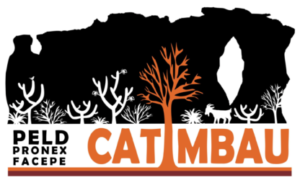- Albuquerque-Lima et al., 2024 – Reproductive isolation between two sympatric bat-pollinated Bauhinia (Leguminosae)
- Lima-Nascimento et al., 2024 – Management practices of Cereus jamacaru DC in the Caatinga dry forest differentially affect its reproductive phenology, fruit set and nectar availability
- Silva et al., 2024 – How does bitter taste guide the utilization of medicinal plants in the semiarid region of Brazil?
- Souza et al., 2024 – Assessing Plant Resource Utilization across Wet and Dry Landscapes in Northeast Brazil
- Albuquerque et al., 2024 – How Do Local Medical Systems Work? An Overview of the Evidence
- Souza et al., 2024 – Patterns of Biological and Utilitarian Diversity of Plants Through a Dry Forest Precipitation Gradient
- Vanderlei et al., 2024 – Human disturbances reduce tree abundance and stimulate woody plant resprouting and clonal growth in a tropical dry forest
- Oliveira et al., 2024 – Rapid recovery of ant-mediated seed dispersal service along secondary succession in a Caatinga dry forest
- Silva et al., 2024 – Divergent reproductive responses of Caatinga dry forest plants to leaf-cutting ant herbivory
- Oliveira et al., 2024 – Recovery of the reproductive functional diversity of edible fruit plant assemblages along the regeneration of a Caatinga dry forest
- Kulka et al., 2024 – Increased aridity and chronic anthropogenic disturbance reduce litter productivity in a Caatinga dry forest
- Kulka et al., 2024 – Chronic anthropogenic disturbance alters litter decomposition and nutrient concentrations and stocks across a Caatinga dry forest chronosequence
- Noutcheua et al., 2024 – Chronic human disturbance and environmental forces drive the regeneration mechanisms of a Caatinga dry tropical forest
- Gomes et al., 2024 – Plant vegetative propagation plays a considerable role in the regeneration following slash-and-burn agriculture in Caatinga dry forest
Publicações 2013
Publicações 2014
5. Leal et al 2014 – The Multiple impacts of Leaf-Cutting Ants and Their Novel Ecological Role in Human-Modified Neotropical Forests. Biotropica
4. Leal et al 2014 – Anthropogenic disturbance reduces seed‑dispersal services for myrmecochorous plants in the Brazilian Caatinga. Oecologia
3. Nascimento et al 2014 – The introduced tree Prosopis juliflora is a serious threat to native species of the Brazilian Caatinga vegetation. Science of the Total Environment
2. Almeida et al 2014 – The alien flora of Brazilian Caatinga: deliberate introductions expand the contingent of potential invaders. In: Biological Invasions
Publicações 2015
3. Leal et al 2015a – The Benefits of Myrmecochory: A Matter of Stature. Biotropica
2. Leal et al 2015b – Disturbance Winners or Losers? Plants Bearing Extrafloral Nectaries in Brazilian Caatinga. Biotropica
Publicações 2016
4. Ito et al 2016 – What is for dinner? First report of human blood in the diet of the hairy-legged vampire bat Diphylla ecaudata
3. Oliveira et al 2016 – Chronic anthropogenic disturbance as a secondary driver of ant community structure: interactions with soil type in Brazilian Caatinga. Environmental Conservation
2. Ribeiro-Neto et al 2016 – Chronic anthropogenic disturbance causes homogenization of plant and ant communities in the Brazilian Caatinga. Biodiversity and Conservation
Publicações 2017
5. Barbier et al 2017 – From the Atlantic Forest to the borders of Amazonia: species richness, distribution, and host association of ectoparasitic flies (Diptera: Nycteribiidae and Streblidae) in northeastern Brazil
4. Sousa et al 2017 – Predictors of Arbuscular Mycorrhizal Fungal Communities in the Brazilian Tropical Dry Forest. Microbial Ecology
3. Domingos-Melo et al 2017 – Complex flowers and rare pollinators: Does ant pollination in Ditassa show a stable system in Asclepiadoideae (Apocynaceae)?
2. Rito et al 2017 – Euphorbiaceae responses to chronic anthropogenic disturbances in Caatinga vegetation: from species proliferation to biotic homogenization. Plant Ecology.
- Rito et al 2017 – Precipitation mediates the effect of human disturbance on the Brazilian Caatinga vegetation. Journal of Ecology.
Publicações 2018
Pesquisa FAPESP 266
15. Fivorante, C – A corrosão da Caatinga
Revista Ciência & Cultura: Edição especial Caatinga
Tabarelli, M. & Leal, I – Apresentação
12. Albuquerque, U.P; Melo, F.P.L. – Socioecologia da Caatinga
10. Fernandes, M.F; Queiroz, L.P. – Vegetação e flora da Caatinga
7. Marinho et al 2018 – Checklist of arbuscular mycorrhizal fungi in tropical forests. Sydowia
Publicações 2019
18. Domingos-Melo et al 2019 – It’s raining fragrant nectar in the Caatinga: evidence of nectar olfactory signaling in bat-pollinated flowers. Bulletin of the Ecological Society of America
17. Diniz et al 2019- Flowers up! The effect of floral height along the shoot axis on the fitness of bat pollinated species. Annals of Botany
16. Marinho et al 2019 – High diversity of arbuscular mycorrhizal fungi in natural and anthropized sites of a Brazilian tropical dry forest (Caatinga). Fungal Ecology
15. Silva et al 2019 – A Small Elevational Gradient Shows Negative Bottom-to-Top Bryophyte Richness in a Seasonally Dry Forest in Brazil. Cryptogamie Bryologie
14. Otálora-Ardila et al 2019 – Thermally-assisted monitoring of bat abundance in an exceptional cave in Brazil’s Caatinga drylands. Acta Chiropterologica
13. Zorger et al 2019 – Functional organization of woody plant assemblages along precipitation and human disturbance gradients in a seasonally dry tropical forest. Biotropica
12. Silva et al 2019 – Spatiotemporal responses of ant communities across a disturbance gradient: the role of behavioral traits. Insectes Sociaux
11. Camara et al 2019 Anthropogenic disturbance and rainfall variation threaten the stability of plant–ant interactions in the Brazilian Caatinga. Ecography
10. Oliveira et al 2019 Effects of increasing aridity and chronic anthropogenic disturbance on seed dispersal by ants in Brazilian Caatinga. Journal of Animal Ecology
9. Santos et al 2019 – Frugivory by birds in four species of Cactaceae in the Caatinga, a dry forest in Brazil. Iheringia, Série Zoologia
8. Las-casas et al 2019 – The avifauna of the Catimbau National Park, an important protected area in the Brazilian semiarid. Revista Brasileira de Ornitologia
7. Silva et al 2019 – Extrafloral nectar as a driver of ant community spatial structure along disturbance and rainfall gradients in Brazilian dry forest.Journal of Tropical
6. Pinho et al 2019 – Plant functional assembly is mediated by rainfall and soil conditions in a seasonally dry tropical forest. Basic and Applied Ecology
5. Neri et al 2019 – Green versus green? Adverting potential conflicts between windpower generation and biodiversity conservation in Brazil. Perspectives in Ecology and Conservation
4. Ribeiro et al 2019 – Functional diversity and composition of Caatinga woody flora are negatively impacted by chronic anthropogenic disturbance. Journal of Ecology
3. Silva et al 2019 – Climate change will reduce suitable Caatinga dry forest habitat for endemic plants with disproportionate impacts on specialized reproductive strategies. PLOS ONE
2. Souza et al 2019 – Multiple drivers of aboveground biomass in a human-modified landscape of the Caatinga dry forest. Forest Ecology and Management.
Publicações 2020
23. Chaves et al 2020 – Hunters’ preferences and perceptions as hunting predictors in a semiarid ecosystem. Science of the Total Environment
22. Barbier et al 2020 – Ecology of Antricola ticks in a bat cave in north-eastern Brazil. Experimental and Applied Acarology
21. Melo et al 2020 – Adding forests to the water–energy–food nexus. Nature Sustainability
20. Albuquerque-Lima et al 2020 – An explosion of perfume: Mass flowering and sphingophily in the Caatinga dry region in Brazil. Plant Species Biology
19. Rocha et al 2020 – Reproductive biology of columnar cacti: are bats the only protagonists in the pollination of Pilosocereus, a typical chiropterophilous genus? Folia Geobot
18. Domingos-Melo et al 2020 – The dark side of the rain: self-pollination setbacks due to water exposure in Pavonia varians Moric (Malvaceae), a species with rain-dependent flowering.Acta Botanica Brasilica
17. Barbosa et al 2020 – Reproductive biology of Syagrus coronata (Arecaceae): sex-biased insect visitation and the unusual case of scent emission by peduncular bracts. Plant Biology
16. Oliveira et al 2020 – An endemic lizard of Catimbau National Park, Pernambuco, Brazil, as prey of Tropidurus cocorobensis (Squamata, Tropiduridae). Herpetology Notes
15. Carvalho et al 2020 – Ants as providers of ecosystem services in Caatinga: How to inform society about ecological research. Journal of Environmental Analysis and Progress
14. Oliveira et al 2020 – Plant protection services mediated by extrafloral nectaries decline with aridity but are not influenced by chronic anthropogenic disturbance in Brazilian Caatinga. Journal of Ecology
13. Menezes et al 2020 – Introduced goats reduce the diversity and biomass of herbs in Caatinga dry forest. Land Degradation & Development
12. Gonçalves et al 2020 – The palm Syagrus coronata proliferates and structures vascular epiphyte assemblages in a human-modified landscape of the Caatinga. Journal of Tropical Ecology
11. Alves et al 2020 – Landscape-scale patterns and drivers of novel mammal communities in a human-modified protected area. Landscape Ecol
10. Andrade et al 2020 – Rainfall reduction increases insect herbivory in tropical herb communities. Journal of Vegetation Science
9. Trindade et al 2020 – Water availability mediates functional shifts across ontogenetic stages in a regenerating seasonally dry tropical forest. Journal of Vegetation Science
8. Knoechelmann et al 2020 – Leaf-cutting ants negatively impact the regeneration of the Caatinga dry forest across abandoned pastures. Biotropica
7. Pereira et al 2020 – Intense mycorrhizal root colonization in a human-modified landscape of the Caatinga dry forest. Forest Ecology and Management
6. Silva et al 2020 – Land use, soil properties and climate variables influence the nematode communities in the Caatinga dry forest. Applied Soil Ecology
5. Szyja et al 2020 – Neglected but Potent Dry Forest Players: Ecological Role and Ecosystem Service Provision of Biological Soil Crusts in the Human-Modified Caatinga. Frontiers in Ecology and Evolution
4. Silva et al 2020 – Divergent responses of plant reproductive strategies to chronic anthropogenic disturbance and aridity in the Caatinga dry forest. Science of the Total Environment.
3. Maia et al 2020 – Species diversity of Glomeromycota in Brazilian biomes. Sydowia
2. Passos et al 2020 – Arbuscular Mycorrhizal Fungal Community Structure in the Rhizosphere of Three Plant Species of Crystalline and Sedimentary Areas in the Brazilian Dry Forest. Microbial Ecology.
Publicações 2021
16. Domingos-Melo et al 2021 – Nocturnal ant integrates generalist pollination system in the Caatinga dry forest Brazilian Journal of Biology
15. Rito et al 2021 – Unraveling the drivers of plant taxonomic and phylogenetic β‑diversity in a human‑modified tropical dry forest. Biodiversity and Conservation
14. Aecyo et al 2021 – Plastome evolution in the Caesalpinia group (Leguminosae) and its application in phylogenomics and populations genetics. Planta
13. Domingos-Melo et al 2021- Sweet Rain- from Bat-Pollinated Flowers: How Does Sugar Concentration Modulate Nectar Retention? International Journal of Plant Sciences
12. Leal et al 2021a – First record of albinism in a mustached bat (Chiroptera, Mormoopidae) from South America. Notas sobre Mamíferos Sudamericanos
11. Leal et al 2021b – Morcegos cavernícolas do carste arenítico do Parque Nacional do catimbau, Nordeste do Brasil. Mastozoología Neotropical
10. Leal et al 2021c – Mobility of bats between caves: ecological aspects and implications for conservation and environmental licensing activities in Brazil. Studies on neotropical fauna and environment
8. Laurentino et al 2021 – Socioeconomic and ecological indicators in willingness to accept compensation for the conservation of medicinal plants in a tropical dry forest. Environment, Development and Sustainability
7. Filgueiras et al 2021 – Recovery of dung beetle assemblages in regenerating Caatinga dry forests following slash-and-burn agriculture. Forest Ecology and Management
6. Gonçalves et al 2021 – Livelihood strategies and use of forest resources in a protected area in the Brazilian semiarid. Environment, Development and Sustainability
5. Gonçalves et al 2021 – Effects of domestic wood collection on tree community structure in a human-dominated seasonally dry tropical forest. Journal of Arid Environments
4. Vanderlei et al 2021 – Extensive clonal propagation and resprouting drive the regeneration of a Brazilian dry forest. Journal of Tropical Ecology
3. Jamelli et al 2021 – Habitat use and feeding behavior of domestic free-ranging goats in a seasonal tropical dry forest. Journal of Arid Environments
2. Silva et al 2021 – Effect of land use and seasonality on nematode faunal structure and ecosystem functions in the Caatinga dry forest. European Journal of Soil Biology




